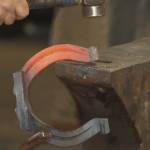Trimming and Shoeing Intervals for Horses

“My horse has had this set of shoes on for over three months now, and they’re still pretty tight!”
This hypothetical horse owner might be saving a little money on farrier visits, but the chances are good that his horse is paying a different kind of price. The recommendation to have a horse’s hooves trimmed and shoes reset about every six weeks is not just to keep farriers busy; it’s mainly to keep horses sound and comfortable, in both the short and long terms.
A horse’s hooves tend to grow over and around a shoe’s edges within six weeks, so the shoe is no longer protecting the hoof wall from wear and chipping. Because the walls of the hoof slope out, the bottom edge of the hoof is also becoming slightly wider during this time, even though the shoe doesn’t stretch. Finally, most shoes will loosen a bit as the nail heads start to pull the clinches (the clipped-off and bent ends of nails that protrude from the outside of the hoof) through the wall.
The long-term problems can be more severe. Because the toe of the hoof grows somewhat faster than the heel, the horse’s hoof angle changes as time passes after a trim or reset. Within six weeks, the angle of the front of the hoof will no longer match the pastern angle. This change to the natural angle puts added strain on the joints and tendons within the hoof, leading in time to inflammation, arthritic changes, and lameness.
Trimming at regular intervals keeps the hoof from getting greatly misaligned and allows smaller corrections to the hoof angle. If horses are trimmed after several months, the angles before and after trimming will be quite different, and it will be more difficult for the structures within the hoof to adapt to the sudden change.
For barefoot horses, the hoof angle may not change as much because the toe tends to wear or chip as the horse moves around, keeping the rim of the hoof somewhat closer to level. Regular trimming is still important, especially for horses that are on grass or are not exercised a lot. Horses that spend a most of their time on hard dirt or rocky surfaces will tend to keep their hooves worn down more than those that are pastured on grass.








